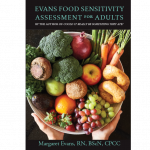
Order the Assessment!
Evans Food Sensitivity Assessment for Adults

HOPE is absolutely my favourite word and favourite topic! Where do we find it when we are lost? How can we nourish it in times of adversity? How do we support others to find it? Wendy Schlessel Harpham is a physician, a cancer patient and a healthy survivor of her disease. She has written multiple books related to her cancer journey and has some very inspiring things to say about HOPE.
The topic is on my mind as I spoke over the weekend at the B.C. Parkinson’s Society new diagnosis day. As I spoke to both the patients and caregivers that were there it was clear that they were looking for HOPE – hope that their disease could be well controlled – hope that they would have the courage they know it will take to travel the journey – hope that they will have friends and family who will rise in support – and hope that medical science will quickly find an answer to relieve their suffering.
So, whether you have a chronic disease, a child with a health problem where you are searching for answers, or a work or life story that feels overwhelming, it is possible to nourish hope. Read Wendy’s list of the types of hope below and then explore ways that you can nourish and cultivate healthy hope both for yourself and for others in your life.
1. Wishful thinking: “A type of hope based on fantasy.” It can be temporarily helpful if it helps you distract yourself in the midst of a difficult situation. Dreaming of winning the lottery and relieving your financial struggles might feel helpful for a short while but will not, realistically, provide any real solutions. It can also prevent you from seeking opportunities to find real solutions to your challenges.
2. Blind hope: “A unquestioning belief in someone or something based on unearned trust”. This type of hope allows you to believe in anything you want but doesn’t offer a connection to anything real or practically helpful.
3. Empty hope: “This is the appearance of hopefulness for the benefit of others.” It is pretending to be hopeful so that the people around you believe you are “fine”. Unless you can honestly connect to hope and make this experience true for you, it offers only a place of hiding from your true feelings and experience.
4. False hope: “This is hoping for something that can’t possibly come true.” It drains much needed energy away from finding solutions and answers as you put energy into something that is doomed to fail.
5. Realistic hope: “This is belief in the possible.” It is based on facts and realistic ideas so this type of hope is very strong.
6. Faithful hope: “This is belief in something that is beyond your control” Strong faith helps you make sense of the unpredictable and unexplainable things that happen in your life. It does not compete with realistic hope but adds to it. It suggests the phrase, “Pray as if everything depends on God and act as if everything depends on you.”
7. Healthy hope: “This is belief that your situation can actually improve.” Realistic hope and faithful hope form the foundation of healthy hope. By embracing and nourishing this type of hope in your circumstance and your life, you are better able to find the courage and the strength to keep going. In the midst of the most difficult adversity, looking for places that offer a realistic chance of something positive makes the journey feel less overwhelming.
This information is from Wendy Schlessel Harpham’s book called “Happiness in a Storm” It is her story of facing illness and embracing life as a healthy survivor. No matter what type of adversity you are facing, it offers loads of hope and practical wisdom. Check out her website for loads of inspiring articles at www.wendyharpham.com
Take time to nourish both realistic and faithful hope for yourself. Look for the places where you can take a concrete step to improve your situation or connect to stories of others who have overcome similar circumstances. Find a faith that you can lean on in the most difficult moments when nothing seems to make sense and you feel lost. Begin each day by connecting to healthy hope and nourish it as you go.